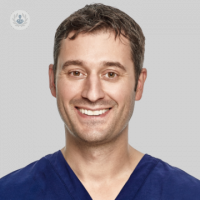How to treat severe periodontitis
Escrito por:Around 18 million Britons currently have some form of periodontitis (gum disease), of which about 12 percent have a severe form. Many patients suffer from periodontitis without knowing it.

In this article, Dr Ruben Garcia, a leading London based dentist, lets us know how periodontitis is treated and how guided tissue regeneration works.
How does periodontal treatment and guided tissue regenerations work?
Many patients overlook unremarkable symptoms such as bleeding gums, redness or bad breath. They only become aware of their periodontal disease at a later stage, when the gums recede, the tooth neck gets painful or the teeth even become loose. An early diagnosis is important as it improves the chances of a successful treatment.
While the cleaning of the periodontal pockets in the early stages is usually sufficient, severe periodontitis requires the additional administration of antibiotics. If this therapy is not enough and some gum pockets remain, the gum may have to be lifted surgically and the teeth cleaned under visual inspection.
During the healing process, the gums very often shrink and expose the tooth neck. Especially for front teeth that can result in very long teeth. This is where ‘Guided Tissue Regeneration (GTR)’ comes into play. It is sometimes also used in combination with growth agents or bone replacement materials for posterior teeth.
Restoration of the periodontium
The periodontium consists of different types of tissue, which behave differently after severe periodontitis. The gums, for example, grow very fast to close the wounds. On the other hand, the root cementum, the collagen fiber bundles or the alveolar bone take more time to heal. The GTR now ensures that these structures grow faster, to ensure a firm hold of the teeth and to stop the proliferation of the gums into the former pocket.
However, the GTR is only able to achieve sustainable tissue regeneration with the precondition of optimal oral hygiene and successful pocket management.
Under local anesthesia, the root surface is exposed and cleaned. To create a barrier between the pocket lining and the root surface, a special membrane is used. This creates a cavity that the periodontium can use for regeneration. A removal of the membrane is not necessary, when using resorbable membranes.
Depending on the extent and type of tissue loss, it may be useful to include additional bone substitute material to replenish the bone defect. Special gels applied to the root surface can also stimulate tissue regeneration.
How successful is this treatment? What are the risks and costs?
Since the treatment with the membrane can be quite complex, it is normally only conducted by an experienced periodontist. Potential complications such as infections or death of the gingival papilla occur extremely rarely.
Overall, the success rates of the GTR are quite high. Especially if the defect is rather deep and narrow instead of flat and wide, the membrane remains covered by the gums and the risk of infection is very low.
What aftercare is necessary for this procedure?
For the first two weeks after the procedure, patients should not brush the treated site and only use mouthwash. The success of the treatment can only be concluded with a review after six months. It depends significantly on the patient to keep the successful result.
Periodontitis is associated with a lifelong aftercare, because the inflammation can flare up even after a good treatment. Therefore, you should have thorough oral hygiene with an electric toothbrush, use fluoride toothpaste and interdental brushes, have regular check-ups with the dentist, and regular dental hygiene to clean the hard-to-reach areas.
The preservation of your teeth will pay off by avoiding complex implantations. Your own teeth are still the best!
If you will require periodontal care, we recommend booking an appointment with an extremely experienced dentist such as Dr Ruben Garcia. Click here to visit his profile today.


